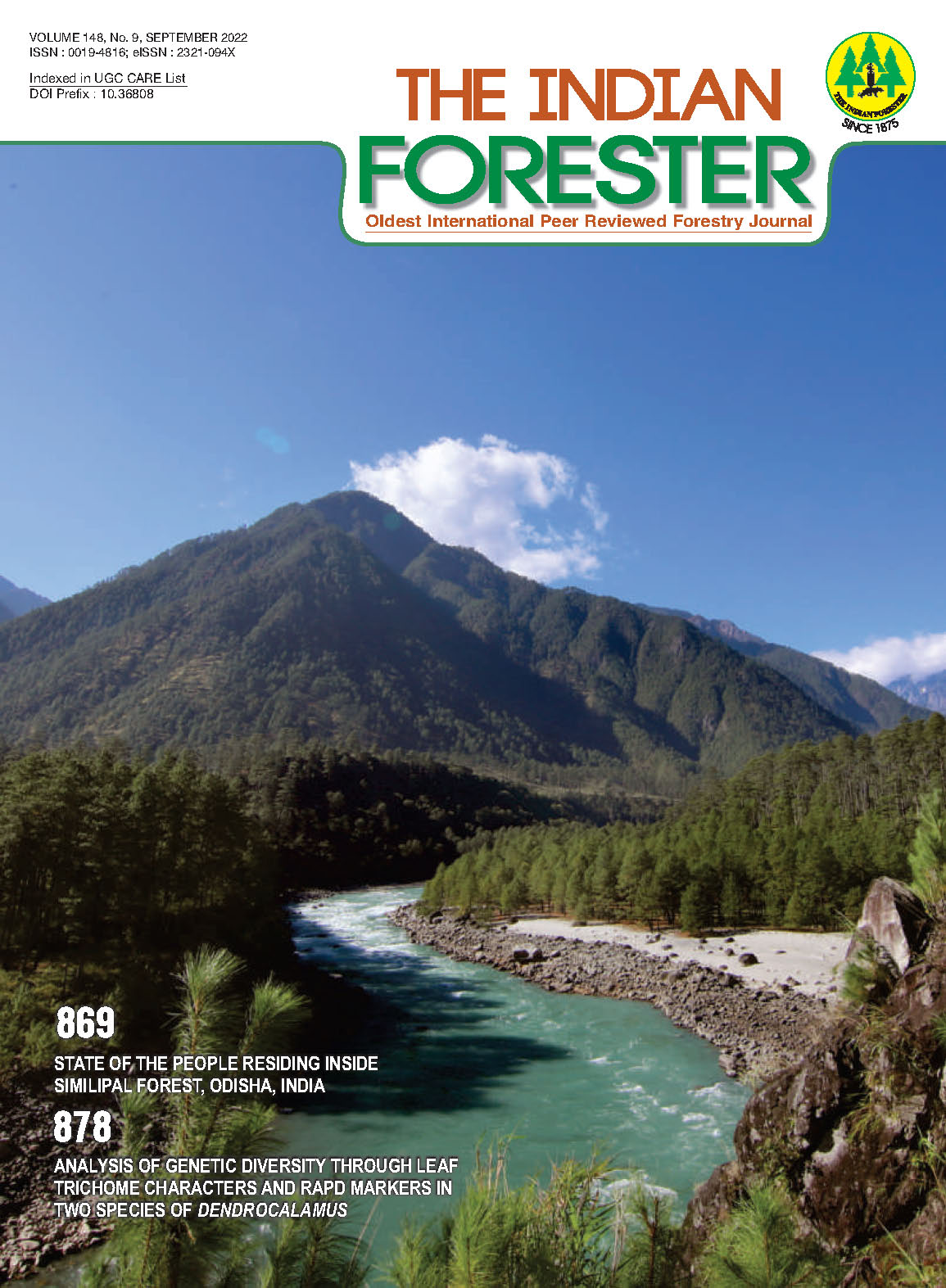Notes on Risks of Ecological and Social Disturbances in Patalkot, a Subterranean Inhabitation of Satpura Hills, Madhya Pradesh
DOI:
https://doi.org/10.36808/if/2022/v148i9/155639Abstract
No Abstract.References
Acharya D. (2013). Patalkot Issues. http://www.patalkot.com/ patalkot-issues/ Acharya D. and Rai M.K. (2006). Traditional knowledge for curing various ailments among Gonds and Bharias of Patalkot valley, MP, India. http://www.selfgrowth.com/ articles/ Acharya12.html
Asthana A.K. and Nath V. (2007). Hepatics and Anthocerotes (Bryophyta) of Tamia and Patalkot valley (district Chhindwara), Madhya Pradesh. Journal of Bombay Natural History Society, 104: 275-287.
Bhattacharya R. and Bhattacharya A. (2002). Resource utilisation among the Bharias of Patalkot in Central India. In Global Perception of Tribal Research in India, Ed.
Patel, M. L. Atlantic Publishers and Distributors, New Delhi, pp 47-68 Champion H.G. and Seth S.K. (1968). A Revised Survey of the Forest types of India. Government of India Press, Delhi, India, pp 199-201
Gooden B., French K., Turner P.J. and Downey P.O. (2009). Impact threshold for an alien plant invader, Lantana camara L., on native plant communities. Biological Conservation, 142: 2631-2641.
Gupta R., Nath V. and Asthana A.K. (2013). Present scenario of moss diversity at Tamia hills and Patalkot valley (Madhya Pradesh) India. National Academy Science Letters, 36: 629-634.
Jagtap S., Gilda S., Bhondave P., Paradkar A., Pawar P. and Harsulkar A. (2009). Validation of the potential of Eulophiaochreata L. Tubers for its anti-inflammatory and antioxidant activity. Pharmacology online, 2: 307-316.
Khobragade N.D., Prasad H. and Meshram M. (2013). Report on Biodiversity Status of Chhindwara. Institutional Report, Centre for Forestry Research and Human Resource Development, Chhindwara.
Kohli R.K., Batish D.R., Singh H.P. and Dogra K.S. (2006). Status, invasiveness and environmental threats of three tropical American invasive weeds (Parthenium hysterophorus L., Ageratum conyzoides L., Lantana camara L.) in India.
Biological Invasion, 8: 1501-1510 Legris P. and Meher-Homji V.M. (1979). The Deccan trap country and its vegetation patterns. Bulletin of Indian National Science Academy, 45: 108-126.
Nath V. and Khatri P.K. (2010). Traditional knowledge on ethnomedicinal uses prevailing in tribal pockets of Chhindwara and Betul Districts, Madhya Pradesh, India. African Journal of Pharmacy and Pharmacology, 4: 662-670
Pandey G.D. and Tiwari R.S. (2003). A study of socio cultural factors affecting reproductive health among the primitive tribes of Madhya Pradesh. In Demography and Health profile of the tribes, Ed. Deepak Adak, Anmol Publications, New Delhi, pp 297
Patil H.M. (2012). Ethnobotanical Notes on Satpura Hills of Nandurbar District, Maharashtra, India. Research Journal of Recent Sciences, 1: 326-328.
Rai M.K. (1988). Ethno-medicinal survey of Patalkot and Tamiya (District Chhindwara)-1. Plants used against skin diseases and liver disorders. Journal of Economic Taxonomic Botany, 12: 337-344.
Rao V.G., Bhat J., Yadav R., Gopi P.G., Selvakumar N. and Wares D.F. (2010). Prevalence of pulmonary tuberculosis among the Bharia, a primitive tribe of Madhya Pradesh, central India. International Journal of Tuberculosis and Lung Disease, 14: 368-370.
Rawat R.K., Trivedi R.K. and Soni L. (2007). Patalkot Landslide, Madhya Pradesh-A Case Study. Journal of Geological Society of India, 69: 344-346.
Sharma D. and Alam A. (2011). Present status of liverwort diversity at Pachmarhi (Madhya Pradesh). Journal of Indian Botanical Society, 90: 332-338.
Sharma G.P., Raghubanshi A.S. and Singh J.S. (2005). Lantana invasion: an overview. Weed Biological Management, 5: 157-165.
Singh S. and Khatri P.K. (2014). Documentation and distribution of Forest Invasive Species (FIS) of Jabalpur, Katni, Mandla and Seoni Districts of Madhya Pradesh. Project
Completion Report, Indian Council of Forestry Research and Education, Dehradun. Uhl Jr. V.W. (1979). Occurrence of groundwater in the Satpura Hills region of central India. Journal of Hydrology, 41: 123-141.
Venkateswaran R. and Parthasarathy N. (2003). Tropical dry evergreen forests on the Coromandel coast of India: structure, composition and human disturbance. Ecotropica, 9: 45-58.
Downloads
Downloads
Published
How to Cite
Issue
Section
License
Unless otherwise stated, copyright or similar rights in all materials presented on the site, including graphical images, are owned by Indian Forester.





